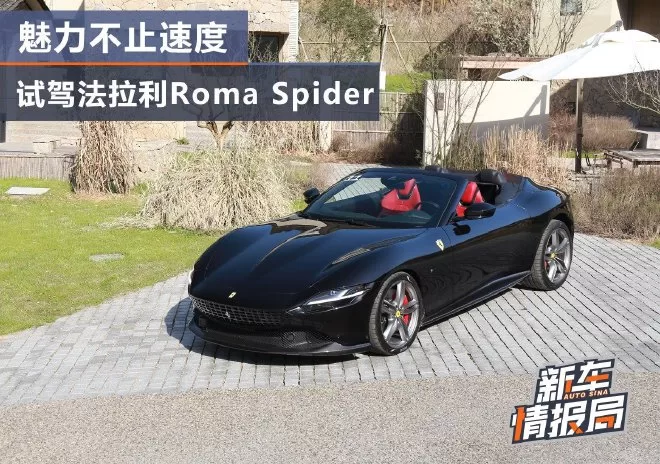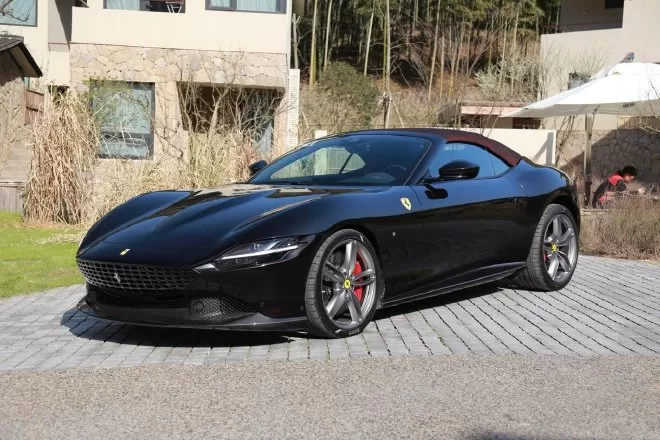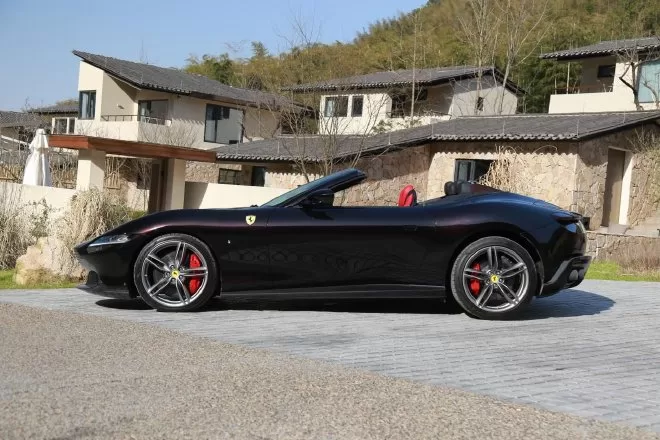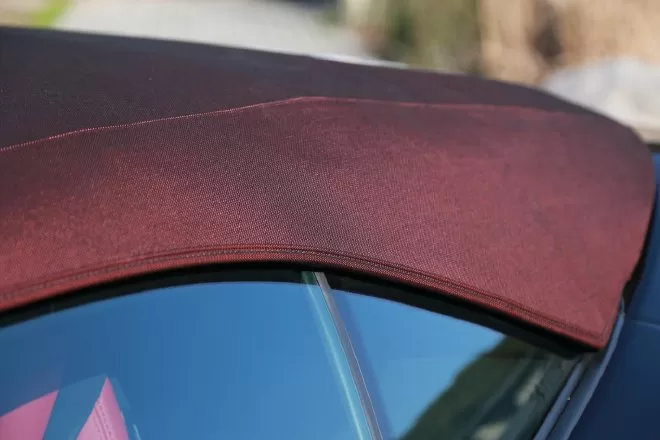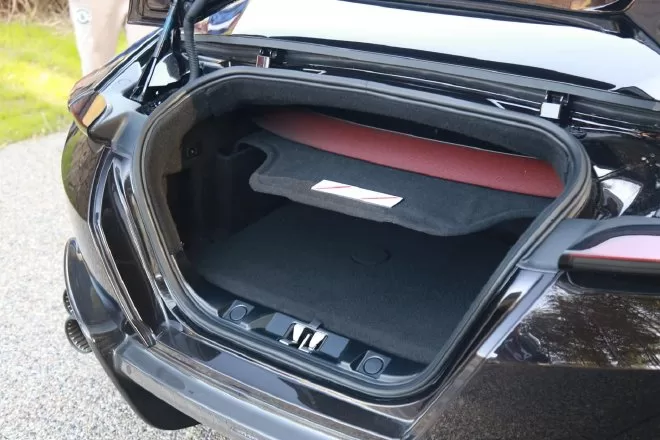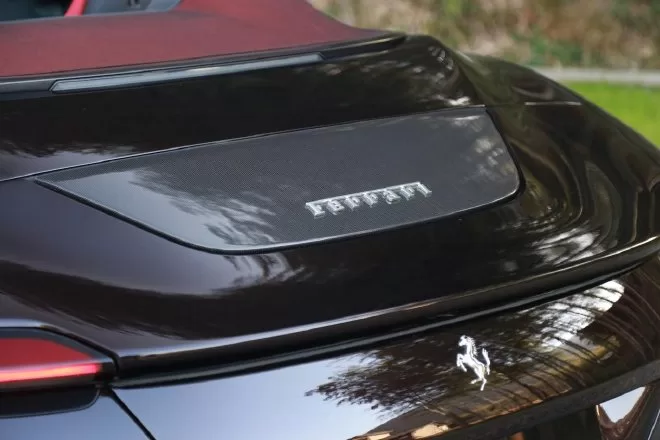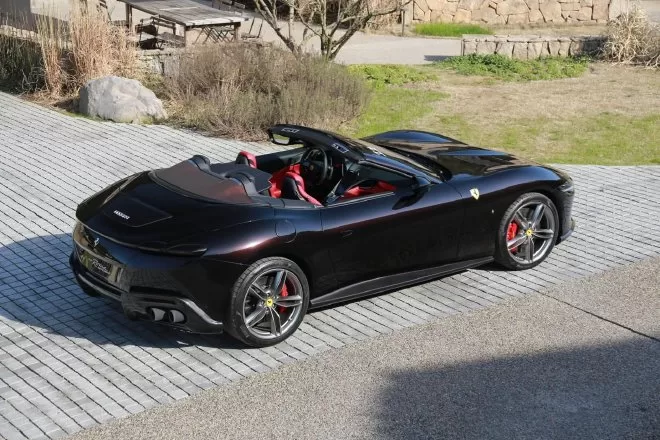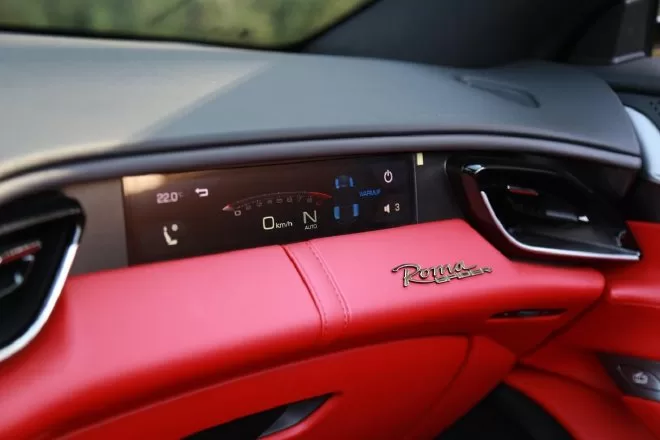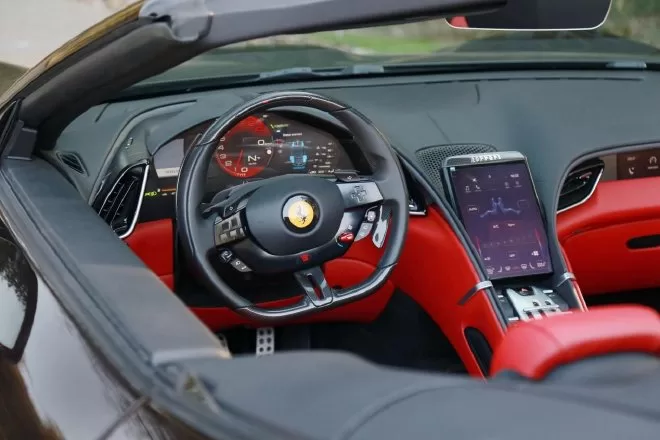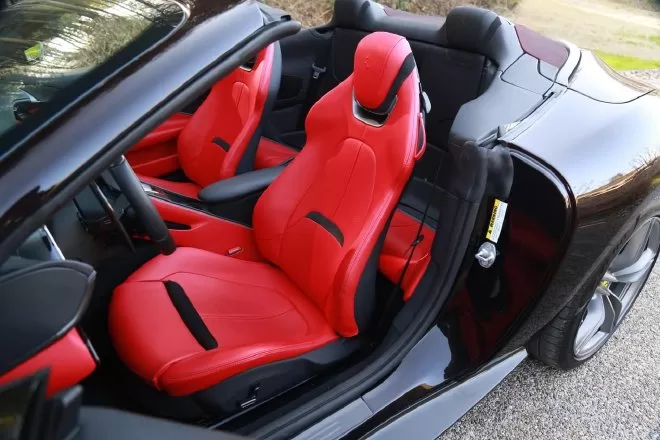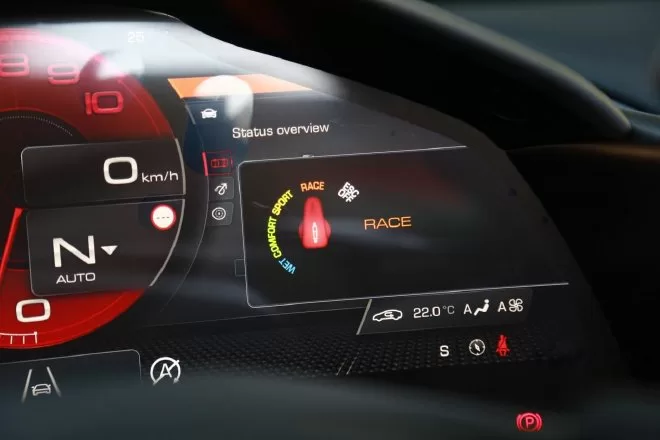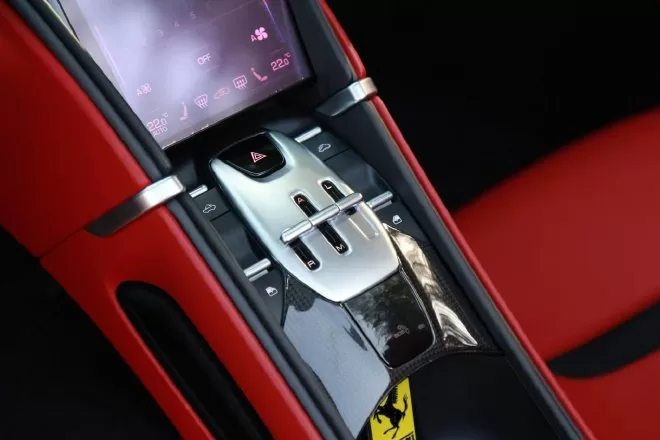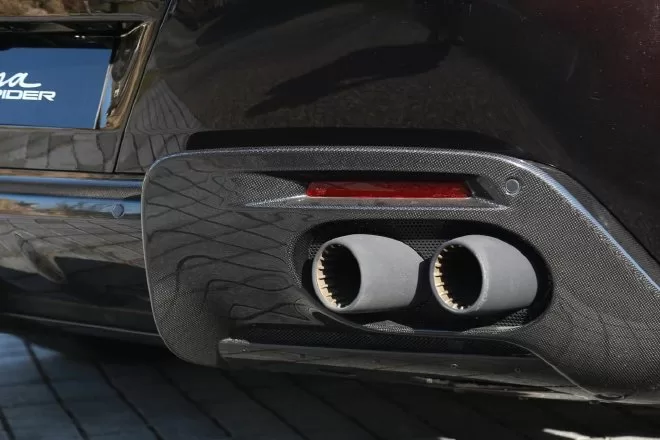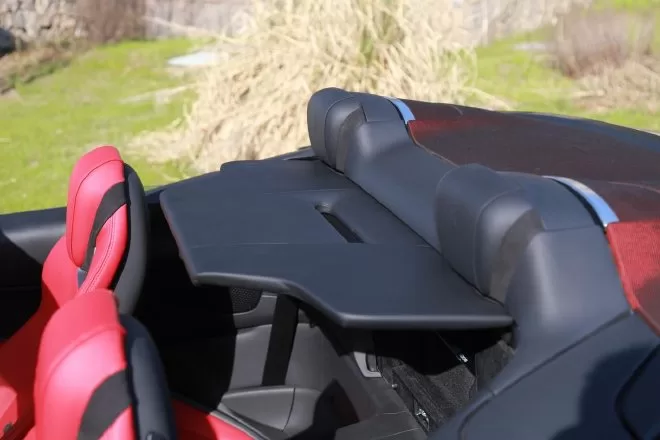What is your perception of the Ferrari brand? Yes, whether you are a car enthusiast or not, the ultimate performance is always the first label that comes to mind. And as a brand with many supercars, luxury, sophistication, and romance are actually the least prominent labels. However, in this respect, Ferrari still has absolute hardcore strength, because whenever you see any Ferrari on the street, the first reaction is definitely not how fast this car is, but rather – this car is really beautiful. As an entry-level Ferrari product, the Roma is equally worthy of such attention, and to take it further, Ferrari has also derived another more distinctive soft-top convertible version: the Roma Spider.
The Roma Spider’s unique design sets it apart from other Ferrari models. It is a fuel-powered car, but it features a shark-nose front end commonly seen on electric cars, with a sharper and rectangular grille, along with less elongated headlights. This design, resembling a pursed mouth, is significantly different from Ferrari’s classic wide and flat front end. When it comes to personality, it’s definitely worth mentioning among Ferrari models.
The front of the car is designed for aerodynamics, with a low and contoured hood that allows air to flow quickly and generate more downforce, directing airflow where it needs to go.
As a sports car, the extraordinary appearance is definitely a scene on the road at present, ideally it pursues “traveling with the wind”. However, the body shape of the Roma Spider clearly pursues a more flowing and futuristic feeling, presenting a smoother and more sleek form. Its body lacks the typical aerodynamic design lines and kits of Ferrari’s higher-level supercars, and there are no large diffusers even under the rear of the car.
For so many years, Ferrari has only used soft top design for the Spider models of 360 and F430, and now the Ferrari Roma Spider becomes the third. Its engine is placed in the front of the cockpit, so the front of the car looks long and the driver’s seat looks relatively rearward. In terms of dimensions, its length, width, and height are 4656/1974/1306, with a wheelbase of 2670mm. From the data, it actually wants to adapt to more environments outside the track.
The soft top is the most eye-catching feature of the Roma Spider, allowing for operation at speeds of up to 60km/h and completing the process in just 13.5 seconds. Due to being a convertible, the vehicle has additional mechanical hardware and body modifications, resulting in an 84KG weight increase compared to the standard Roma.
It is worth mentioning that its convertible top is not the usual rain cover of a convertible car, but has a sophisticated woven texture that reflects a unique color in the sunlight, giving it a delicate and exquisite feel.
And regarding the trunk loading capacity, as shown in the figure, although it looks small, it has already achieved top-level loading capacity among this type of sports car.
The rear spoiler integrates with the body of the car, only raising when necessary, providing up to 95 kilograms of downforce, controlled by the computer throughout, unable to be operated manually.
Because of the front engine position, the design of the rear of the car can be more bold. The sleek lines and powerful rear fenders of the Roma Spider make it easy to cut through the air, whether the convertible top is open or closed, the car has a very elegant rear end. Its futuristic feel also extends to the taillights, the family-style taillight cluster makes it easy to see that it is a Ferrari.
The hub is the classic thin-spoke design of Ferrari, with bright red paint on the brake calipers, and the tire part chooses the Pirelli P ZERO series street tires with a focus on performance and handling. The specifications are 245/35 ZR20 for the front tires and 285/35 ZR20 for the rear tires.
Compared to the technological feel of the exterior, the interior of the Roma Spider is traditional supercar style. Like any Ferrari, everything in the cockpit is designed for driving. The driver and passenger are embraced separately, and the various functions of the center console are well organized. The abundance of exposed carbon fiber and leather materials enhances the atmosphere of the car.
However, Ferrari is not conservative in the application of new technology. It has three screens in the cockpit: a 16-inch full LCD instrument panel, an 8.4-inch vertical central control screen, and an 8.8-inch co-driver screen.
Similarly, it embraces technology in the application of driving assistance systems, with a mainstream set of ADAS including lane-keeping system, lane departure warning, emergency brake assist, driver monitoring system, to provide better safety for passengers without sacrificing driving pleasure.
The steering wheel is made of leather and carbon fiber, with controls for wipers, turn signals, one-touch start button, and driving mode selector, all designed to keep the driver focused on driving.
Sitting in the driver’s seat, the Roma Spider delivers the same sense of control as many other sports cars. However, it lacks the feeling of “sitting in a pit” that other Ferraris have. The head and knee space is not important, and the rear seats are only suitable for storage.
The powertrain remains the same as the Roma, with a 3.9T twin-turbo V8 engine producing 620 horsepower and 760 Nm of torque. It is paired with an 8-speed dual-clutch transmission, allowing the Roma Spider to accelerate from 0 to 100 km/h in just over three seconds and reach a top speed of 320 km/h.
The driving mode selection continues to be placed on the steering wheel. In different driving modes, the vehicle’s traction, steering, suspension, vehicle stability system, and braking will change. Through precise calculation and control, maximize driving safety and driving pleasure in different driving conditions. WET focuses on maximizing control on wet and slippery road surfaces, SPORT mode emphasizes maximizing performance, and RACE mode declares the GT sports car’s capability on the track. The additional ESC OFF mode allows you to enter full manual mode, like using a film camera to fully control the vehicle’s status.
Its power may not be as wild as you think, but this engine still has the traditional V8 sports car power potential, with full power every minute and every second. The gearbox has a tight power connection and smooth shifting, providing enough confidence for you to maneuver on mountain roads. As a Ferrari user, of course, you also want to keep the engine speed high and shift gears, using violent acceleration and sound waves to stimulate your adrenaline.
Relying on strong low-end torque, it can reach the highest gear at 50 km/h, but this is obviously not what Ferrari drivers want. Tap the shift paddles, and the engine’s sound follows the downshift and is then raised again. The tachometer instantly suppresses the power that is about to burst out, and the pointer will soar when you step on the gas pedal. The powerful power has already worked on your back in an instant, and then the surging power comes up behind you.
Although it does not have the typical design of a large diffuser, the exposed four thick exhaust pipes still remind people that it is not to be trifled with. Ferrari’s musicians have modified the exhaust sound of this engine using traditional craftsmanship. It is not equipped with a muffler, but uses an electronically controlled bypass valve to adjust the engine’s roar. When driving it, you don’t need to constantly watch the tachometer, just listen to the sound to shift gears.
Of course, Ferrari also knows that not all sounds in motion are good, such as wind noise. In this inherently NVH-unable convertible, Ferrari uses the back seat backrest as a wind deflector, whether it’s the special shape of the deflector or the central hole, it can guide the airflow to where it should go during driving, greatly reducing turbulence in the cabin and the resulting noise.
Control is absolutely the least of Ferrari’s concerns, because they are always right, even in a convertible, it can still give you a feeling of sitting on a steel plate, its handling is as agile as a snake, the direction of the steering wheel is a standard “surgical level”. The outstanding chassis allows you to not worry too much about the unruly rear end or the uncontrolled body posture in the bend, all you need to do is aim at the direction you want to go, observe the front and rear conditions of the vehicle, and then turn the steering wheel.
The front double wishbones and rear multi-link, electromagnetic suspension are not the focus. The focus is its performance in comfort and road adaptability, which is very “sporty”. The filtering of shock from the road surface is not as stiff as traditional sports cars. The vibrations and undulations transmitted from the chassis to the driver can even be described as comfortable. When driving it, you no longer need to focus on the stones on the road or slow down before speed bumps. Nowadays, supercars, like civilian cars, are somewhat nostalgic about manual operation. Most of the time, sports cars are more of a scenic route. When it comes to actual driving, I would definitely describe the driving experience of the Roma Spider as effortless. Although it has the foundation of a supercar, driving it is not at all difficult. In summary: When you think of a Ferrari, you most easily associate it with speed. However, clearly, this is a characteristic of Ferrari, but not the sole attribute of the Roma Spider. It is an easy-to-drive convertible sports car, as well as a work of art with beautiful body design. It is more adaptable to the driving and riding scene, so that sitting in the driver’s seat and the passenger seat is not much different. And the low threshold price in the family is also an important reason for consumers to choose it. Of course, most importantly: it is always a Ferrari.
